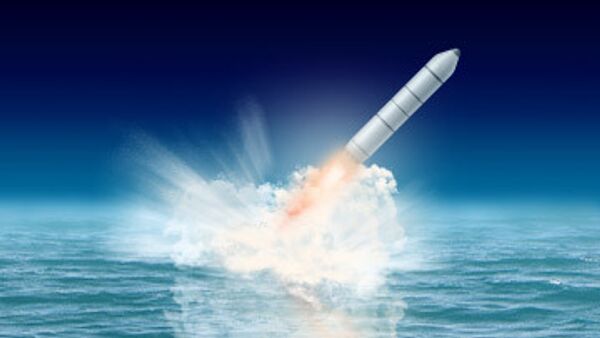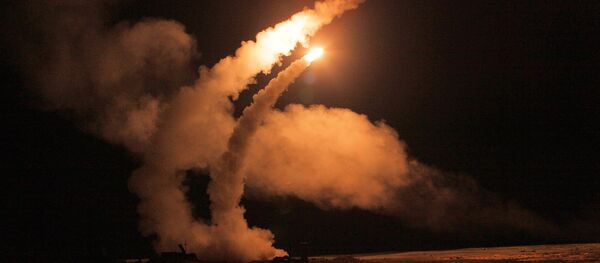On Wednesday, the Northern Fleet-based Yury Dolgorukiy (literally "Yuri the Long-Armed"), Russia's newest generation of strategic missile submarines, launch its payload while submerged in the White Sea. The Bulava ('Mace') missiles flew over 5,900 km over northern Russia before landing at the Kura Test Range in Kamchatka in the Far East.
Speaking to Sputnik, retired Maj. Gen. Vladimir Dvorkin, the former director of the Russian Defense Ministry's missile and aerospace-focused 4th Central Research Institute, said that the launch was an important milestone.
"On the issue of four missiles being launched at once, this is not exactly news. In their own time, salvo launches have involved the launch of up to 16 missiles, i.e., a sub's entire complement," Dvorkin noted. "But this launch was important for the Bulava, which previously faced difficulties in development," he added.
According to the retired officer, the success of Wednesday's launch means that the Bulava's development problems truly are "are a thing of the past."
In August 1991, the K-407 Novomoskovsk, a Delfin-class (NATO 'Delta-class') submarine under development for the Soviet Navy, launched its entire 16 missile payload in a single volley, becoming the first and only strategic missile sub in the world at the time to ever successfully carry out an all-missile salvo.

Difficult Start
The "difficulties in development" mentioned by Maj. Gen. Dvorkin refer to the fact that the development of the Bulava missile began in the late 1990s, at a very difficult time for the Russian defense industry. Russia had just faced nearly a decade of economic malaise following the Soviet collapse, compounded by the August 1998 default and the loss of many engineers, who had gone to work in the West.
The first launch of the Bulava took place in September 2005, with an underwater test launch taking place in December of that year. Both tests were successful. However, the years that followed saw a series of failures, with test launches conducted between 2006 and 2009 suffering a broad array of software problems, self destructing missiles, course deviation, instability in the third stage of flight, etc.
The problems, Protopopov noted, stemmed not so much from the design of the missile, but poor performance of the enterprises tasked with building its components. These problems saw the missile's introduction into service pushed back, with the Navy adopting it only in early 2013, at the same time that the fourth-gen strategic missile submarine Yury Dolgorukiy was finally commissioned (Russia originally planned to build eight Borei-class subs by 2015).

Sign of Better Times to Come
Following a reorganization which accounted for and resolved these problems, further testing in 2010, 2011 and 2012 proved successful, and the missiles were commissioned a year later. The new missiles' introduction coincided with a much broader campaign affecting Russia's entire defense sector, which culminated in the removal of Defense Minister Anatoliy Serdyukov (accused of large-scale misappropriations of defense funds) and the appointment of Sergei Shoigu. Shoigu canceled many of Serdyukov's reforms, tightened up defense sector funding and quality control standards, and allied himself with the management of the military-industrial complex, much of which saw Serdyukov's reform efforts as a threat to the sector. These measures, together with an injection of funding, have led to substantive improvements across the defense sector.
In the years that followed, two more Borei-class subs, the Aleksandr Nevskiy and the Vladimir Monomakh, entered into service with the Pacific Fleet. The Pacific and Northern Fleets are expected to receive at least five more of the vessels by 2021, with six more upgraded Borei-class subs planned for the mid-to-late 2020s and later. Russia expects to start construction of fifth-gen strategic missile subs after 2025.

The Borei-class and its Bulava missile armament has since become the backbone of the naval component of the Russian nuclear triad, helping to guarantee strategic parity with the US for at least the next 30-40 years. With an operational range of over 8,000 km and a launch mass of 36.8 tons, a single Bulava missile is capable of carrying 6-10 1.15 ton maneuverable, hypersonic warheads with a yield of 150 kilotons apiece, and/or up to 40 decoys. Each Borei-class sub has complement of 16 Bulava missiles onboard.
Together with Bulava, the Russian Navy continues to operate its predecessor, the Sineva, a solid/liquid-fuel three stage missile which is expected to remain in service until at least 2030. That system is carried by Russia's Delifin and Kalmar-class strategic missile subs.


